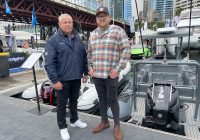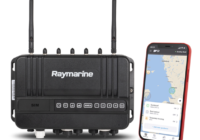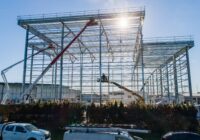Norman R. Wright & Sons has announced the launch of a new custom 12 metre Patrol vessel, custom designed and manufactured for the Queensland Police Service. The new Patrol vessel will join the Wright’s built landing barge, the Stewart Kerlin II currently operating in the QPS fleet, and will be based on their new high performance XLW Class hull form, tested extensively with CFD, built with an advanced composite structure and finished to Wright’s renowned world class standards.
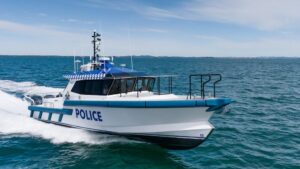
Featuring the Wright’s newly designed and extensively tested XLW Class hull form, the 12 metre offers the seakeeping, stability and ride quality of a much larger vessel. The hull bottom is designed and constructed based on a larger craft, providing a soft ride as the weight it carries is less than a traditional hull of the same waterline length. The relative light weight of the vessel for its waterline length means the hull is very efficient at all speeds. This is further enhanced by a warped planing hull which offers a deep-V at midships and reduces to flatter sections aft to increase stability and efficiency at cruise speeds. It also enhances backing up performance along with reduced running trim angles. The bow retains a large amount of flare meaning the hull offers a very dry ride and the double chine configuration keeps the water well away from the hull.
The new 12 metre XLW hull applies similar design performance principles to that of the 14 metre XLW Class hull featured in Wright’s successful Pilot Boat design, meaning it is able to sustain any sea conditions without any downtime. This ethos was carried through to all aspects of the vessel and included safety, comfort, strength and low maintenance for an optimal user experience.
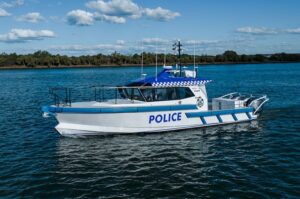
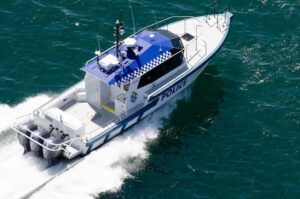
Structurally the boat was engineered by ATL Composites to Wright’s exacting standards and gained DNV approval with Class Notation of 1A HSLC R2 Patrol (S). The R2 operating region exceeds NSCV Category C and allows vessels performing unrelenting patrol duties up to 200 nautical miles off the coastline The hull is designed to withstand a 4G impact loading which exceeds even the minimum requirements of DNV for this class of boat and far exceeds the minimum requirements of NSCV.
The entire boat is fully hand built and every single component is bonded together with E-glass and epoxy resin. No mechanical fasteners are used in the hull structure. The inside and outside skins are E-glass laminated with epoxy resin and reinforced around all high load areas such as the keel and chines. The E-glass is all directional and is laid in specific directions as nominated by the structural engineers to ensure that the optimum strength-to-weight solution is achieved. The entire vessel is foam cored using a marine structural core with high elongation. This is the best core available in the world and is specifically for high speeds vessels with large bottom loadings and has been tested and proven to perform superior to solid glass or aluminium hull bottoms in cases of impact.
Due to the cored nature, a reinforced impact protection zone is fitted along the stem in order to prevent any delamination in the case of a bow strike at speed. The high elongation nature of the core allows it to flex with the attached skins without fatigue over the life of the vessel.
The cored hull allows Wrights to create a monocoque structure where the hull shell forms the majority of the strength of the vessel. All of the internal frames are also foam cored with directional E-glass and carbon fibres laid in the optimum orientation for the best strength to weight solution. The benefit of this type of construction method is that there are no internal secondary structural frames that is common in aluminium boats. The reduced amount of framing in a foam-cored monocoque E-Glass/carbon/epoxy hull is superior in all ways to other materials, this along with the negligible structural maintenance required is factored in to every one of Wright’s custom made boats.
The boat is designed to allow quick and safe movement in all directions and zones. “The aim was to design a boat that has no compromises for functionality as when it is time to perform an intercept, the crew and special personnel can focus on their duties and not be concerned about the vessel performing its support duty,” said Norman R. Wright & Sons Head Naval Architect Adam Evripidou.
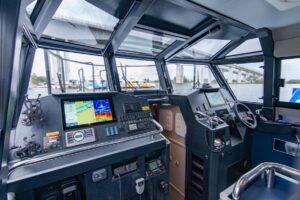
The accommodation is located at the front of the vessel. It includes a divided V-berth with storage under. A watertight access hatch is located in the deckhead to allow the crew to access the foredeck in extreme weather conditions. It also doubles as an escape hatch. The remainder of the area finds a galley located to port in close proximity to the wheelhouse. The open stairway and deck hatch also ensure a large amount of natural light and fresh air throughout the vessel. To starboard is the work centre for the QPS personnel with lockers for all necessary equipment, with full standing headroom adjacent. The hull below the sole is lined with sound deadening tiles to further reduce noise in the cabin.
The wheelhouse is biased aft on the profile of the vessel to put the coxswain and crew in a more comfortable location than the traditional cabin forward configurations. Helm is to starboard and crew seat to port. The coxswain and crew seats are Shockwave suspension seats with the helm also fully adjustable on a Shockwave telescopic unit that will allow the coxswain and crew to be seated and braced while underway, or standing with bolster folded up.
There is a sliding window at both the main helm and crew seat to allow both to liaise with those outside. It also allows the coxswain to view the vessel stern and bow when coming alongside other vessels. There are overhead windows across the top of the windscreen and down the side of the roof to provide a wide range of visibility from the helm with all fitted with solar shade roll-away blinds. A large locker is situated next to the crew seat which provides a large amount of day-to-day storage for the coxswain and crew member and also houses all of the battery isolators and parallel switching so that they are out of the weather.
A large raised dinette for 4 is situated on the port side with flat screen TV on the aft bulkhead. This can be comfortably viewed from the aft facing dinette seat and starboard side settee. A settee is to starboard with hinged backrest which folds up to create an NSCV compliant upper and lower berth. The settee is also designed to allow the stretcher with patient to be strapped securely to the lower settee with the backrest folded up , and there is room to store the stretcher on the back side of the settee backrest. The cabin floor is fitted with large hatches to access all bilge areas for storage. A large unobstructed bilge storage compartment measuring 1.5 cubic meters dominates the under cabin floor area.
A ceiling mounted air conditioning cassette is fitted which expels air in all 4 directions ensuring there are no dead zones in the wheelhouse or accommodation, also providing 100% window demisting enhanced by a separate fan driven ducted system .
The wheelhouse aft bulkhead is fitted with a dogged weathertight door that is of suitable width for fully equipped specialist personnel and a stretcher with patient. The door swings open against the head bulkhead so it can be left open in normal operation. The locker to starboard in the cockpit houses yet another sink which also doubles as the head basin and has storage under. The head is located to port in the cockpit and is fitted with a permanently plumbed fresh and salt water toilet connected to a Sani-Loo treatment system with a hand held shower to allow it to also be used on the aft deck.
The cockpit is large and uninterrupted with a permanent roof overhang providing shade. There is also a removable shade cover over the remainder of the cockpit. Large watertight hatches are located in the cockpit to access all of the areas of the bilge for maintenance and storage. A hinged one-piece door is located in the starboard hull side. This opening is wide enough for a stretcher and is fitted with sockets for a removable ladder, with the extendable ladder able to be used off the foredeck for beach access.
A large locker is fitted aft in the cockpit with the port side housing the petrol generator for safety. The starboard side houses the air-conditioning outdoor unit with both compartments ventilated and protected against sea water mist intrusion by Marine Air Flow International fans and single stage grilles. A 2 tonne stainless steel Samson tow post is fitted on the transom. The locker is stopped short of the hull sides to allow the crew to get all the way to the transom corners to facilitate tying up and intercepts. The top of the locker is fitted with a sacrificial hard wearing bench top to provide an outdoor work bench.
Intercept zones are included with the hull side door open, this is suitable for intercepting a small dinghy or accessing the water. There is one step up to the wide side decks where the midships intercept zone is located. This area is wide and flat and uninterrupted. It is serviced by the overhead fall prevention rail fitted with sliding cars and harnesses which goes around the entire foredeck. The midships zone is ideal for intercepting medium size vessels while the raised foredeck is ideal for coming alongside larger vessels. The inboard mounted safety rail and lack of bow rollers allows the vessel to be alongside large vessels without any chance of impact.
The side decks are kept flat and wide to facilitate quick and safe access around the vessel. The roof can be safely accessed by a port side ladder from the midships intercept zone to allow crew access to all equipment for servicing.
The foredeck is large and uncluttered with the escape hatch located within the safety rail. There is ample room for fully equipped personnel to lie down facing forward, a specific request included in the design brief. The anchor cable and drum winch is accessed through the watertight deck hatch. This intercept zone is completely flat to create a safe platform for bow boarding. The top of the pusher fender is also applied with a non-skid finish and trafficable.
The anchor is self-stowing under the bow pusher fender. When stowed, it is completely clear of the front of the fender to allow for pushing against boats of all types with no crew intervention. The entire sheer is covered in a custom fender which is impenetrable to water, and made in sections no longer than 2m long so any damaged portion can be replaced easily.
Powered by triple Yamaha 425 XTO outboards the boat offers exceptional range featuring a 1500 litre fuel tank. The outboards provide in-water minor servicing along with joystick control to provide superior low speed manoeuvrability along with GPS position-hold functionality. This propulsion package pushes the vessel to speeds exceeding 50 knots.
The semi-customisable design will allow Wrights to cater for any industry requiring an unrelenting patrol boat and will suit applications such as Police, SAR, Defence and Border Protection operations to name a few. Options include full walk-around decks, operators computer console in the cabin, head in the accommodation, full galley in the cabin, aft raked windscreen, twin outboard propulsion and Volvo IPS inboard diesel power.
“We’re excited to have the opportunity design and build a custom vessel with very specific needs, applying our tried and tested XLW Class hull form, with the latest construction techniques and the highly skilled workmanship of our team members,” Adam commented.
For more information visit www.wrightsons.com.au.





